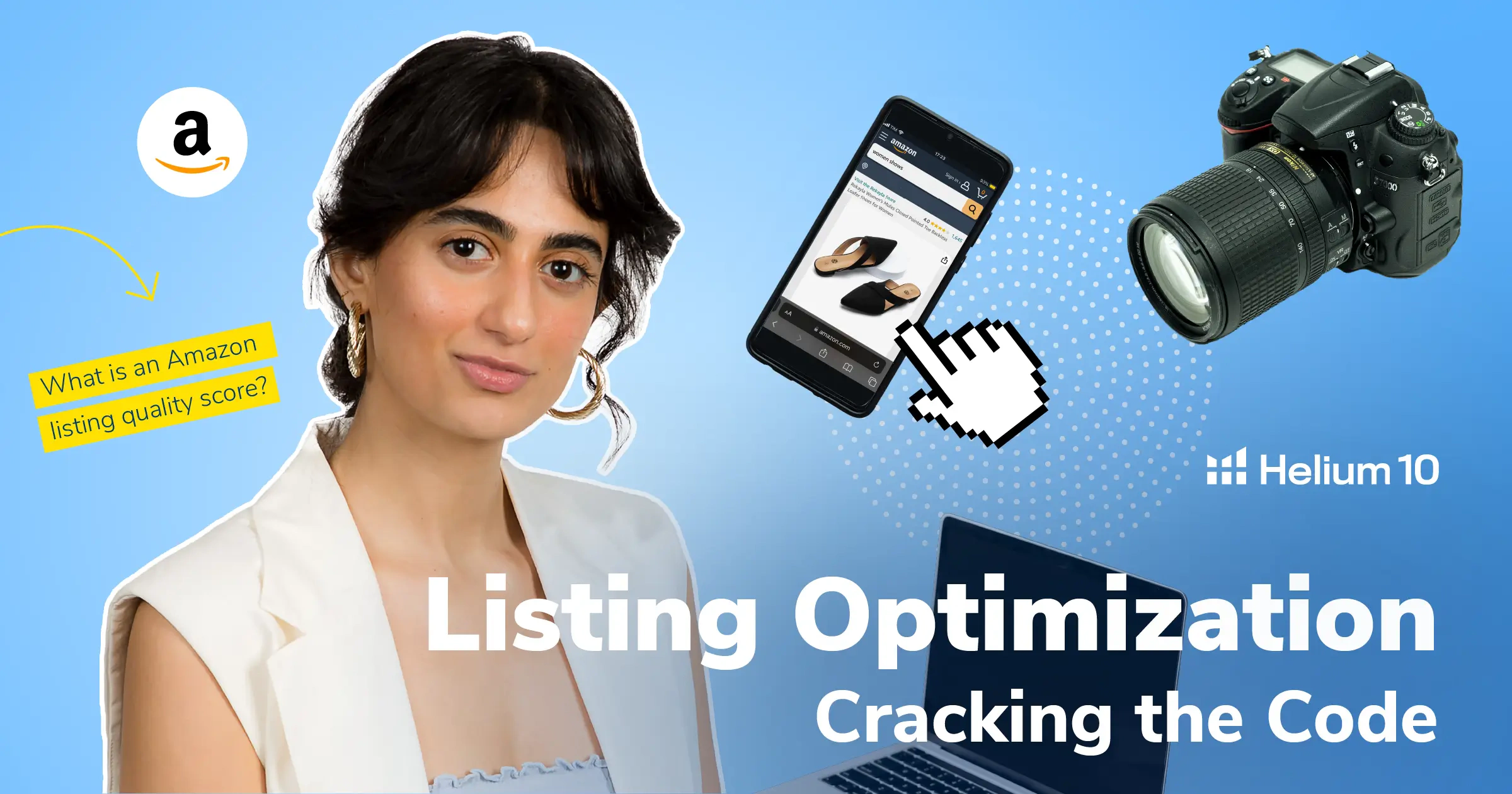
Amazon Product Listing Optimization: Cracking the Code


Table of Contents
- Introduction
- What Is an Amazon Listing?
- What Is Amazon Listing Optimization?
- What Are the Benefits of Amazon Listing Optimization?
- What Tools Should I Use for Amazon Listing Optimization?
- What Is an Amazon Listing Quality Score?
- How Many Keywords Are Allowed per Amazon Listing?
- How Do I Choose the Best Keywords for My Amazon Listing?
- How Do You Optimize an Amazon Product Listing?
- Product Title
- Bullet Points
- Description
- Enhanced Brand Content
- Images
- Search Terms
- Subject Matter
- Reviews
- What Are Other Factors That Impact Amazon Listing Performance?
- Conclusion
Introduction
Amazon listing optimization is more than just a way to make your product page easy on the eyes. It’s a necessary strategy involving several components that have the potential to bring your product listing to page one of Amazon search results, and generate more sales.
Below we will go into the fundamentals of listing optimization on Amazon, the benefits of creating a fully optimized listing, and the components that go into a high-converting Amazon listing.
What Is an Amazon Listing?
An Amazon listing describes the product page shoppers see once they make their search result selection. Product listings include the product title, images highlighting key features, a written description, bullet points, price, customer reviews, and more. This is also where coupon availability, shipping options, customer questions & answers, add to cart button and user-submitted photos are displayed to help shoppers make a more informed buying decision.
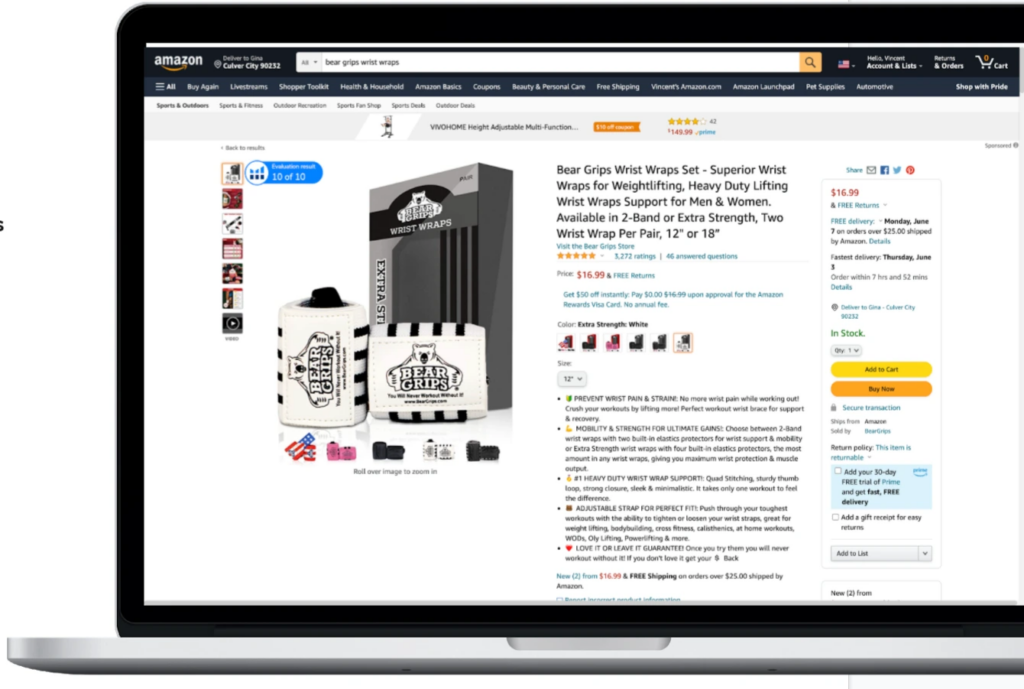
If you are selling on Amazon, be aware it’s not just your product information displayed on your Amazon listing! Through Amazon’s bid-based advertising system, other competitor products also take up real estate on your listing. This includes sections like: “Products related to this item”, “Consider a similar item”, “4 stars and above”, ”Frequently bought together,” or simple display ads located throughout the listing page.
What Is Amazon Listing Optimization?
Listing Optimization on Amazon is the process of tailoring your Amazon product listings to incorporate highly searched and related keywords, appealing and informative imagery, as well as detail-oriented written key features. This is done to enhance your product’s ranking on Amazon search results. Think of Amazon as a search engine, like Google. The goal of Amazon’s search algorithm is to match the phrases shoppers are typing into the search bar with the most relevant products available.
The more relevant keywords and phrases Amazon recognizes within the content of your listing, the more it will promote your listing in search results. The way to make the Amazon algorithm recognize a product as being relevant to a keyword is to either have relevant keywords on your product detail page, or to secure a sale after a buyer has searched for your product through that particular keyword. This is why adding only relevant keywords to your listing page is important, and also adding those keywords throughout different sections of your listing, like the product title, product description, bullet point, back-end search terms, and subject matter.
In short, Amazon listing optimization is one of the most important parts of maintaining and growing a thriving Amazon business because it will determine how your digital “storefront” is perceived by the millions of buyers on Amazon!
What Are the Benefits of Amazon Listing Optimization?
Having an optimized listing is akin to having an organized and well-designed storefront display. To gain a better understanding of why we need to optimize our Amazon listings and the benefits that can be derived from this process, let’s dissect the Amazon selling journey into its various components and examine the role each part plays in it.
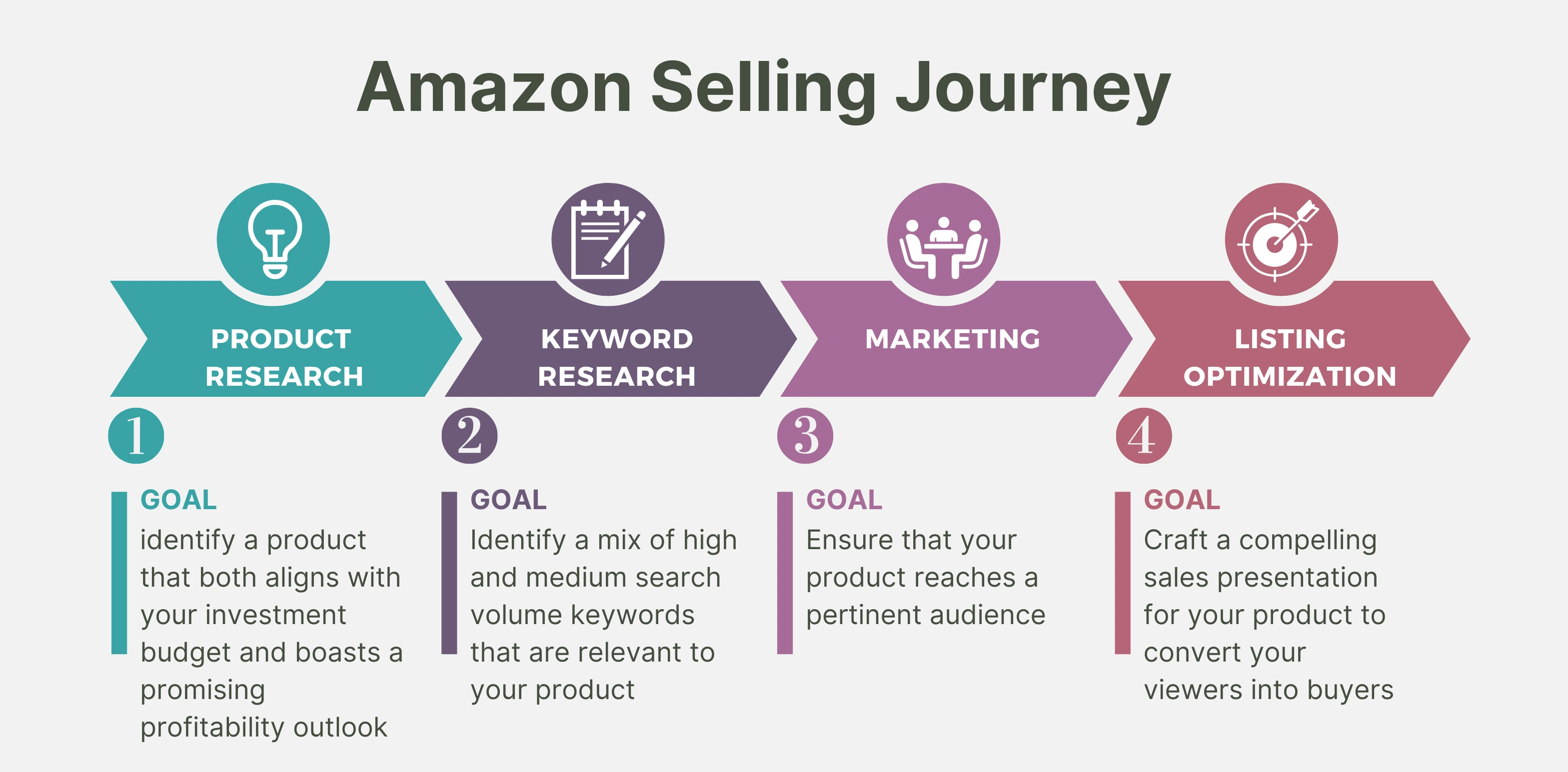
As an Amazon seller, if you’ve excelled in the initial three steps—product research, keyword research, and marketing—yet your product listing isn’t optimized, all the time, resources, and effort invested in your Amazon business might ultimately be futile. This happens because the ultimate goal of this entire journey is to secure a sale. If your listing fails to persuade potential buyers to add your product to their cart, you won’t fulfill your business’ ultimate potential.
In summary, listing optimization offers numerous advantages. To mention a few benefits, an optimized listing provides comprehensive product information, fostering customer satisfaction as it enables buyers to make informed decisions before purchasing. Additionally, this reduces the likelihood of negative feedback since detailed information helps set accurate customer expectations, ensuring they know precisely what to expect when the product is delivered.
What’s more, it helps with the Amazon SEO, meaning it boosts product visibility on Amazon’s search results pages. Crafting product pages with an optimized title, description, and bullet points allows you to potentially rank organically for the keywords within your listing. As a result, your target audience will come across your Amazon listings when they search for these specific keywords. It’s crucial to remember that even if you have an excellent product, it won’t lead to sales if nobody knows it exists.
What Tools Should I Use for Amazon Listing Optimization?
To optimize your Amazon product listing effectively, utilizing the right tools is paramount. Helium 10 offers a comprehensive suite of tools tailor-made for this purpose, and much more.
Before you can begin optimizing your Amazon listing you will need to conduct keyword research. Utilize Cerebro to conduct competitor keyword analysis, gaining valuable insights into high-traffic keywords and competitor keyword strategies. Additionally, Magnet aids in efficient keyword research, providing a vast pool of relevant keywords for enhanced discoverability.
Once you have put together a list of relevant high search volume individual keywords and long tail keyword phrases, you can organize and save it into Helium 10’s My List – Keywords. This allows you to come back to your keywords at any time in the future, and to import these keywords directly into other tools for quick access.
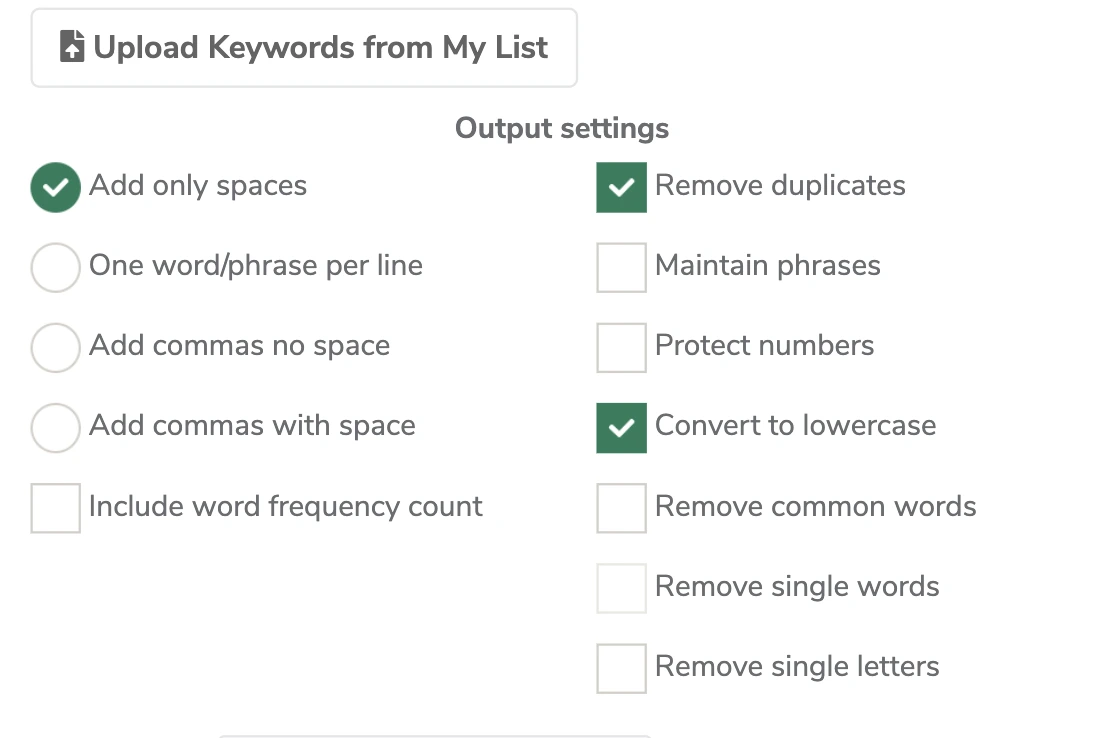
This marks the conclusion of your keyword research, and you can now proceed to listing optimization. The initial step involves using the Listing Analyzer on your top competitors to assess the competition in the market where you sell. This evaluation provides insights into various aspects of an Amazon listing, such as creative assets, top keywords, and listing copy. Once you’ve gained an understanding of your competitors’ strategies and the level of optimization in their listings, you can start planning how to distinguish your brand.
You can begin by processing your keywords into Frankenstein. This tool helps you eliminate duplicates, exclude restricted words, and organize your keywords based on any preferred structure.
Next, you can utilize the Listing Builder to transform these keywords into a product title, product descriptions, bullet points, subject matter, and search terms. If you’re not proficient in copywriting, you can rely on the AI feature within the tool to assist in creating your listing content. To utilize the AI feature, you will need to input your product’s key features as product characteristics, and then click on the “Write it for me” button.
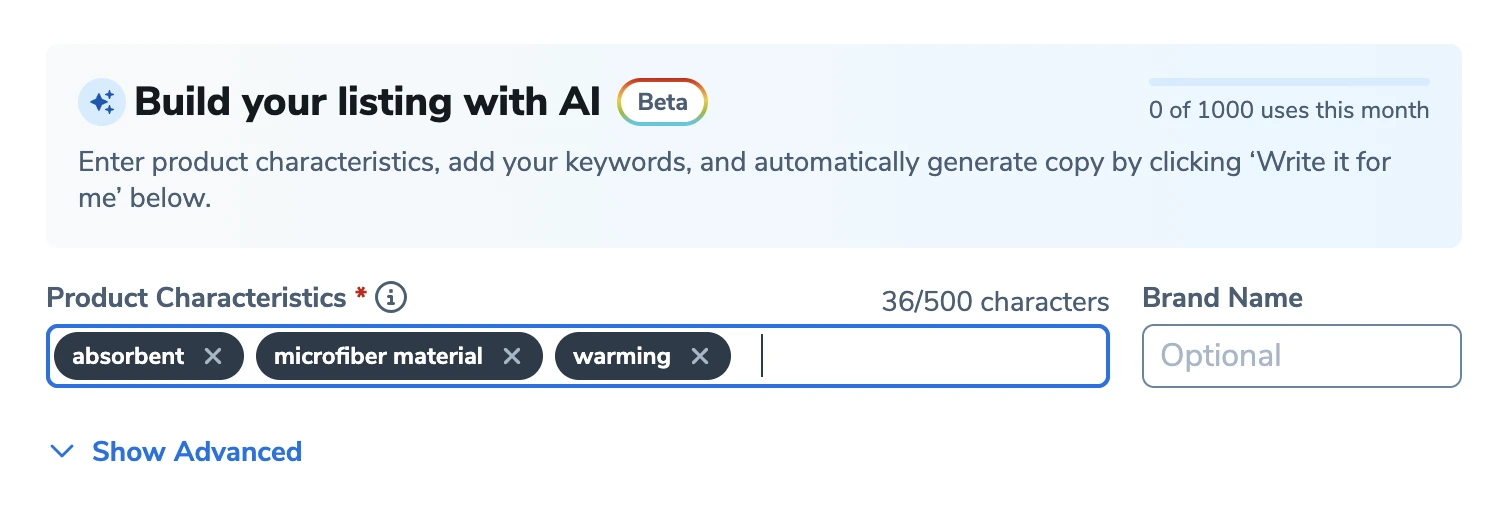
You can simultaneously begin working on optimizing your product images. Audience is a tool that helps you optimize images by running split tests on multiple versions of your listing images, with the objective to increase your click through rate.
Harnessing these tools empowers Amazon sellers to decode the intricacies of Amazon product listing optimization, ultimately enhancing their market presence and search engine optimization.
What Is an Amazon Listing Quality Score?
An Amazon Listing Quality Score is a metric used by Helium 10 to evaluate the quality of product listings. This score is determined by various factors, including the completeness of product information, utilization of all provided slots on the backend, and adherence to Amazon’s guidelines. Achieving a higher listing quality score involves optimizing product titles, product descriptions, product images, videos, and improving your reviews, ultimately enhancing your product’s chances of success on the platform.
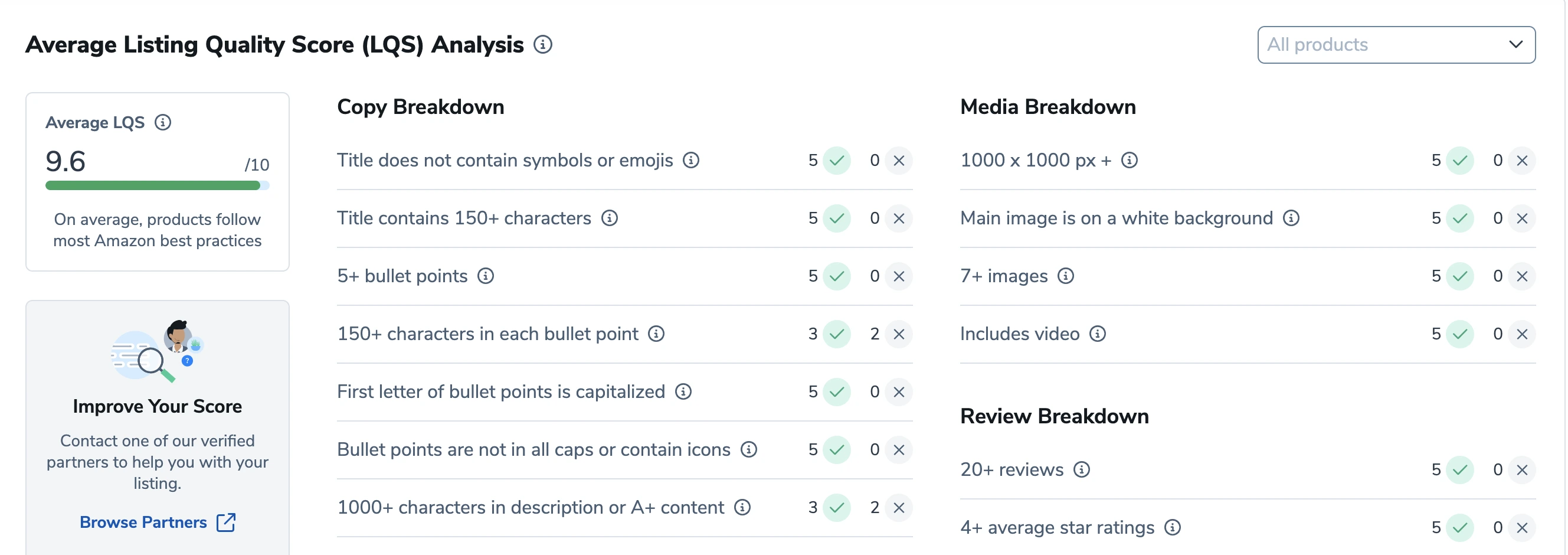
How Many Keywords Are Allowed per Amazon Listing?
Amazon doesn’t have a specific limit on the number of keywords you can use in your product listing. However, it’s essential to focus on relevant and high search volume keywords that accurately describe your product. Quality matters more than quantity so avoid keyword stuffing. Include keywords strategically in your product title, bullet points, description, and backend keywords to maximize visibility and your product ranking for those keywords. Balancing relevance and keyword density is key to successful Amazon product listing optimization.
How Do I Choose the Best Keywords for My Amazon Listing?
Selecting the most effective keywords for your Amazon product listing involves a strategic approach. Begin by understanding your product and identifying words or phrases that potential customers are likely to use when searching. This is not a guessing game, it is impossible to guess what customers are searching for. This is when you need to make data-driven decisions.
Leverage Amazon’s search bar for autocomplete suggestions to gather insights into popular search terms related to your product category. For example if you are selling a yoga mat you can type in the keywords “yoga mat” and then wait Amazon’s auto complete to give you suggestions for keywords related to that keyword phrase.
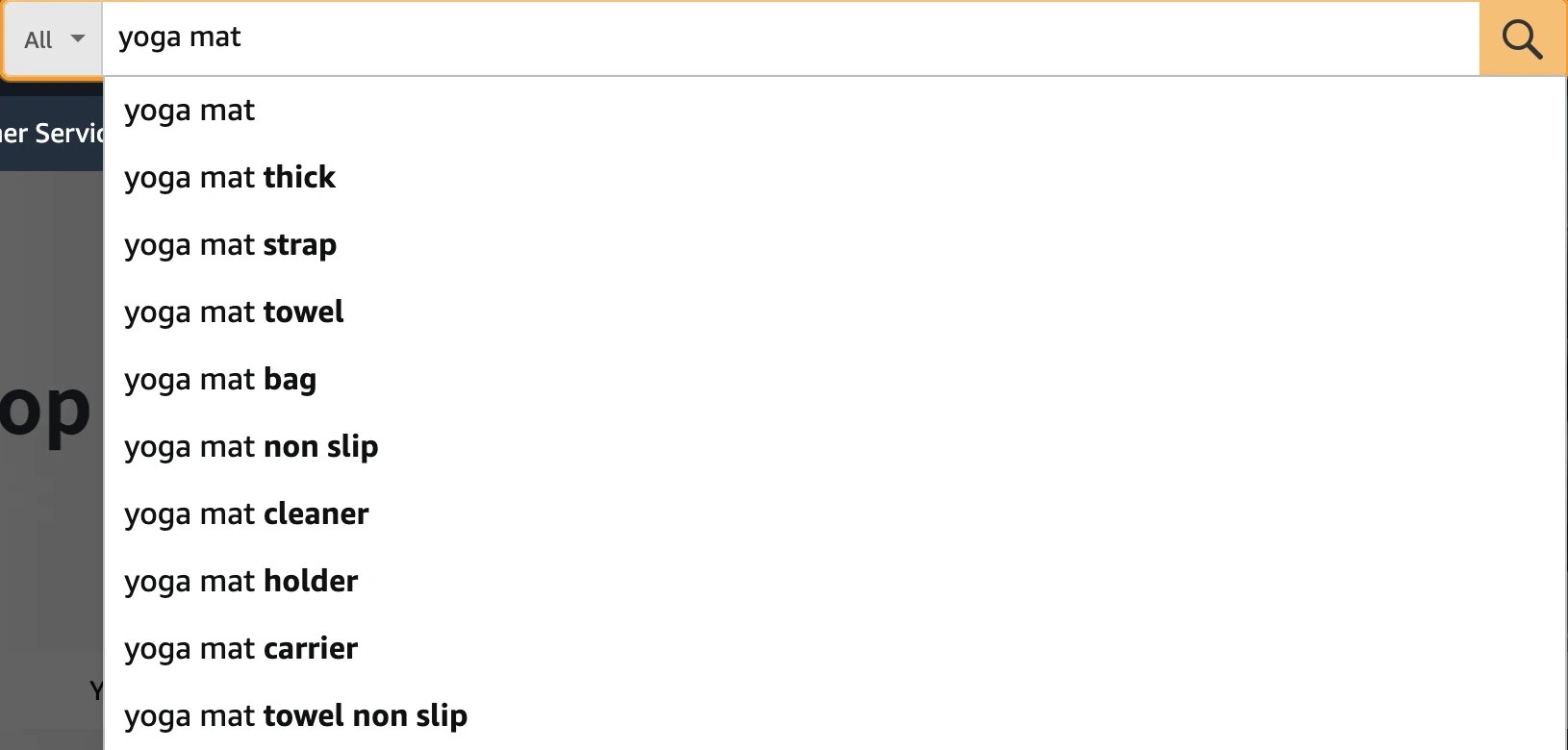
Additionally, utilizing keyword research tools like Helium 10’s Cerebro and Magnet can provide you with a comprehensive list of high traffic keywords and converting keywords.
Aim for a balance between relevance, search volume, and competition when finalizing the keywords for your listing, optimizing its visibility, and driving organic traffic. To learn more about how to conduct keyword research for a new listing, watch this video.
How Do You Optimize an Amazon Product Listing?
Optimizing an Amazon product listing relies on more than just one ingredient. Every listing on Amazon is made up of several different sections that, if crafted correctly, can work together to skyrocket your conversion rate with only a few changes. The product listing sections you’ll want to focus on most include product titles, bullet points, product descriptions, A+ content, product images, search terms, and subject matter.
It’s critical to avoid guesswork as you optimize your Amazon product listing. By enlisting the help of data-driven listing optimization tools, Amazon sellers can pinpoint exactly which keywords to use in their listing and where to place them for maximum ranking potential. Amazon listing optimization tools like Listing Analyzer and Listing Builder give Amazon sellers the ability to not only score their (and their competitors’) product listings, but also leverage high-converting keywords to their fullest potential. At the end of the day, we want to go beyond helping your listing convert. We want you to fully understand how Amazon listing optimization helps you convert so you can replicate the process with future products!
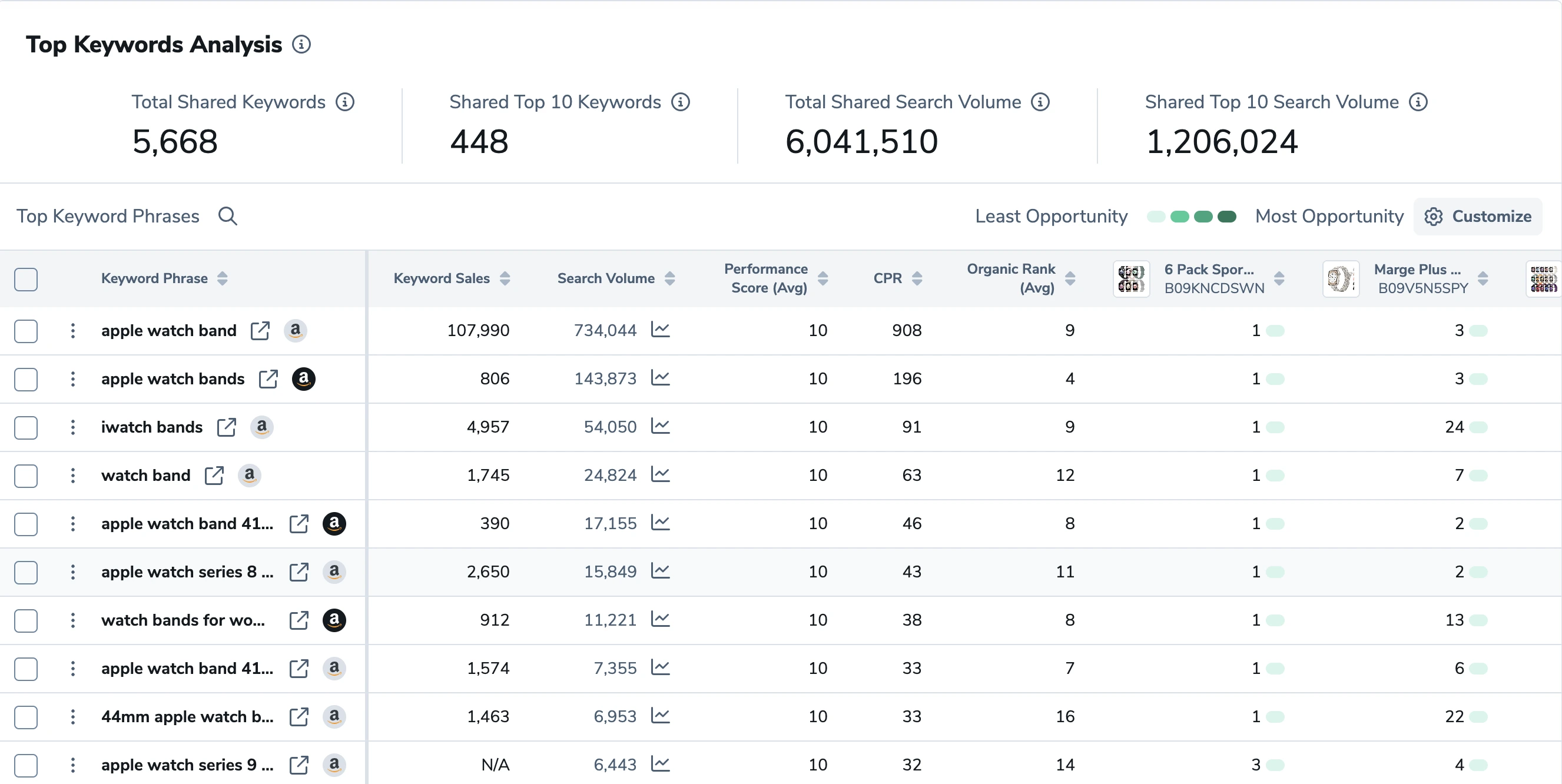
Product Title
Your product title is your storefront sign that needs to capture both the fleeting attention of online shoppers and the critical eyes of the Amazon’s search algorithm. A good Amazon product title accurately reflects what the product is with descriptive language ‒ your product title should never contradict what shoppers are seeing in your main product image. Some important things to keep in mind when constructing an optimized title to increase your CTR are that key information that your customers are looking for should be included in the beginning of the title. E.g. if you are selling a pack of 10, that information should come before any other keyword. Avoid “keyword stuffing,” meaning your product title should still be easily scannable for people and not simply one keyword strung together with another.
When selecting keywords for your product title, it’s advisable to emphasize the key features of the product rather than the specific purposes those features serve. For example, if you’re selling a backpack, it’s more effective to highlight the fact that it has 16 pockets, rather than specifying what each pocket is intended for. While, providing detailed explanations of pocket functions can be helpful for generating ideas for the customer, it might also overwhelm them. Keep the title concise and focused on the product’s standout features.
An optimized title is also optimized for the mobile viewing experience. Customers searching for your product will only see the first 75 characters in the search results so it is key to make those characters count. Have all the relevant details in those first few characters, so that if someone was to only read the visible part of the product title, they would still get a full description of what your product is.

Amazon listing optimization tools, like Listing Builder, allow you to import keywords while helping you track which ones you have used and which ones you have not used within your listing. Not only that, but Listing Builder sorts your chosen keywords by highest (red color coded) to lowest (grey color coded) search volume to help you prioritize more effectively.
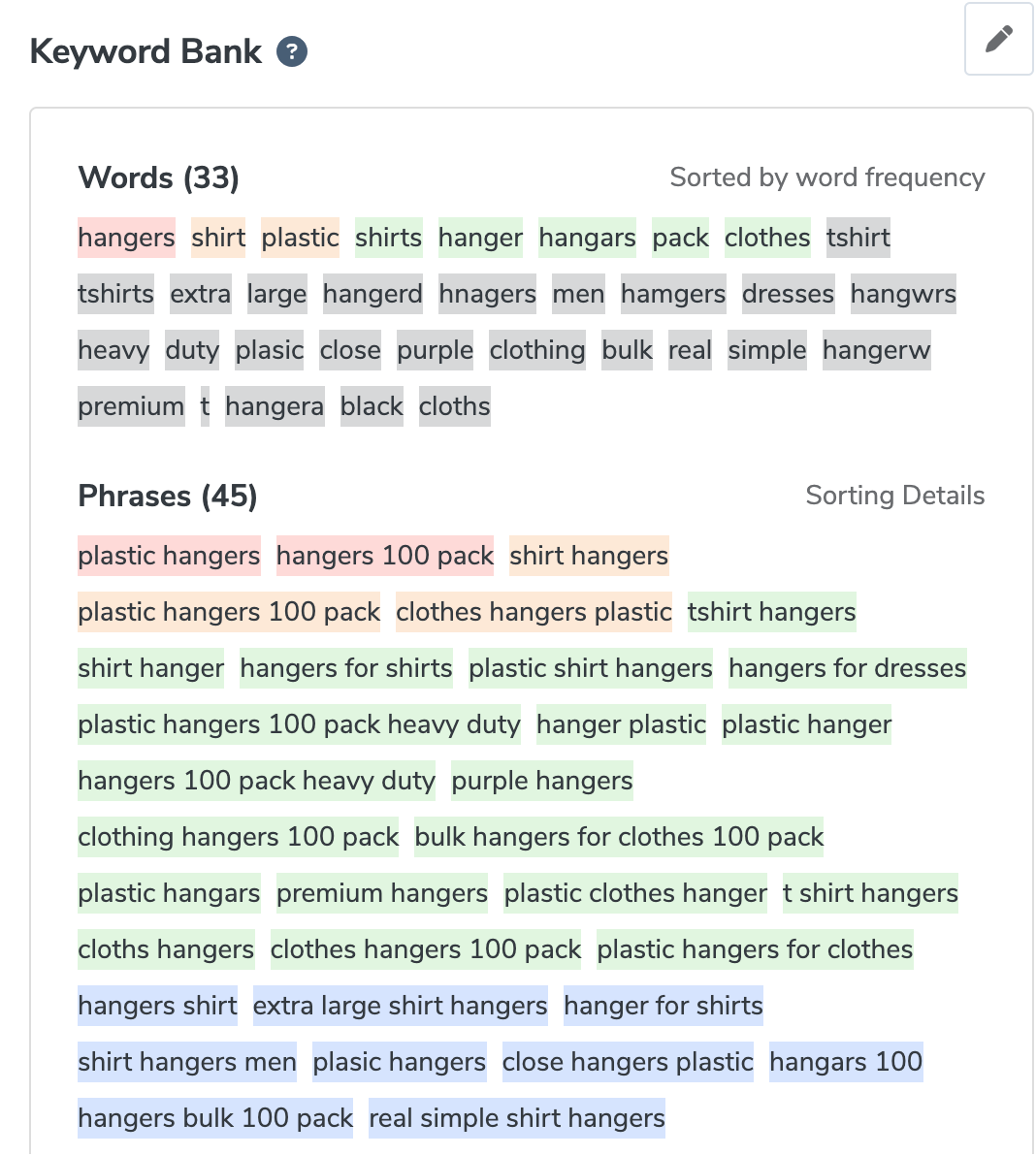
Bullet Points
This is where you can start bragging about all the wonderful things your product brings to the table. Your bullet points are where you should be upselling how your product features benefit the customer using emotionally compelling language in bite-sized highlights. Don’t just tell shoppers that your product makes their lives easier, tell them how. Does your product have a special feature that your competitors lack? Make sure you call attention to it here. Again, your Amazon listing bullet points should include your target keywords in the most natural way possible. Don’t overdo it ‒ no matter how many keywords you squeeze into your listing, your product page won’t convert if it’s hard for shoppers to read!
Description
Take advantage of your Amazon product description ‒ it’s one of the few places you’ll have room to be more long-winded with details of your key product features. Where does your product outperform the competition? What exactly does each of your product’s features mean to a customer who has never purchased from you before? Are there things you’d like to clarify regarding commonly received negative feedback? Are there any questions left unanswered on your competitors’ product detail pages that you want to touch on?
Your product description should leave nothing to doubt while (you guessed it!) including your primary target keywords to help your Amazon listing rank higher.
Enhanced Brand Content
Enhanced Brand Content (now known as A+ Content) describes the elevated content features only available to brand-registered Amazon sellers. A+ content, or Enhanced Brand Content, allows sellers to incorporate additional text-rich imagery, extra bullet points, and comparison charts… all within your product description.
If you aren’t already brand-registered on Amazon, you should be! It’s worth it for A+ Content capabilities alone. A product listing with A+ Content will almost always outsell a listing with traditional, limited product description features. Imagine seeing multiple images like this instead of a text only product description.

Amazon sellers should always take full advantage of any extra leverage Amazon presents for listing optimization. A+ Content, or Enhanced Brand Content, adds a sophisticated brand presence to your listing along with eye-catching imagery options and expanded real estate to hype your product. The more you populate your product detail page with your own brand content, the less space there is available for advertisements from other brands. All this to say, if you want more sales, A+ Content is your best friend.
Images
We are visual beings by nature, and nowhere is a better example of this than online shopping. How many times have you clicked on an Amazon listing without even reading the title because the main image matched up with the idea of what you wanted in your head? Your main and secondary product images are perhaps the most important components of your Amazon listing optimization strategy because the former impacts Click Through Rates (CTR) and the latter impacts Conversion Rates (CVR).
Your Amazon listing should have no less than seven images. These images will vary in style, but this is the number you should plan on for a compelling product page. Your main image is the first thing shoppers will see when viewing your product, so make sure it is high quality and closely follows Amazon’s terms of service. Here are rules to follow to be compliant with the Amazon Terms of Services:
- Your main product image should be against a plain white background
- Avoid low-quality or artificially scaled-up, blurry images
- Avoid badges or icons
- Fill up 85% or more of the image space with your product

The best way to encourage viewers to click on your listing is to formula this simple formula. All the burning questions that a buyer may have should be answered by this image alone. To give you an example, if I were to sell a thick, reversible yoga mat that comes with a bag and a strap this is what my main image would look like.
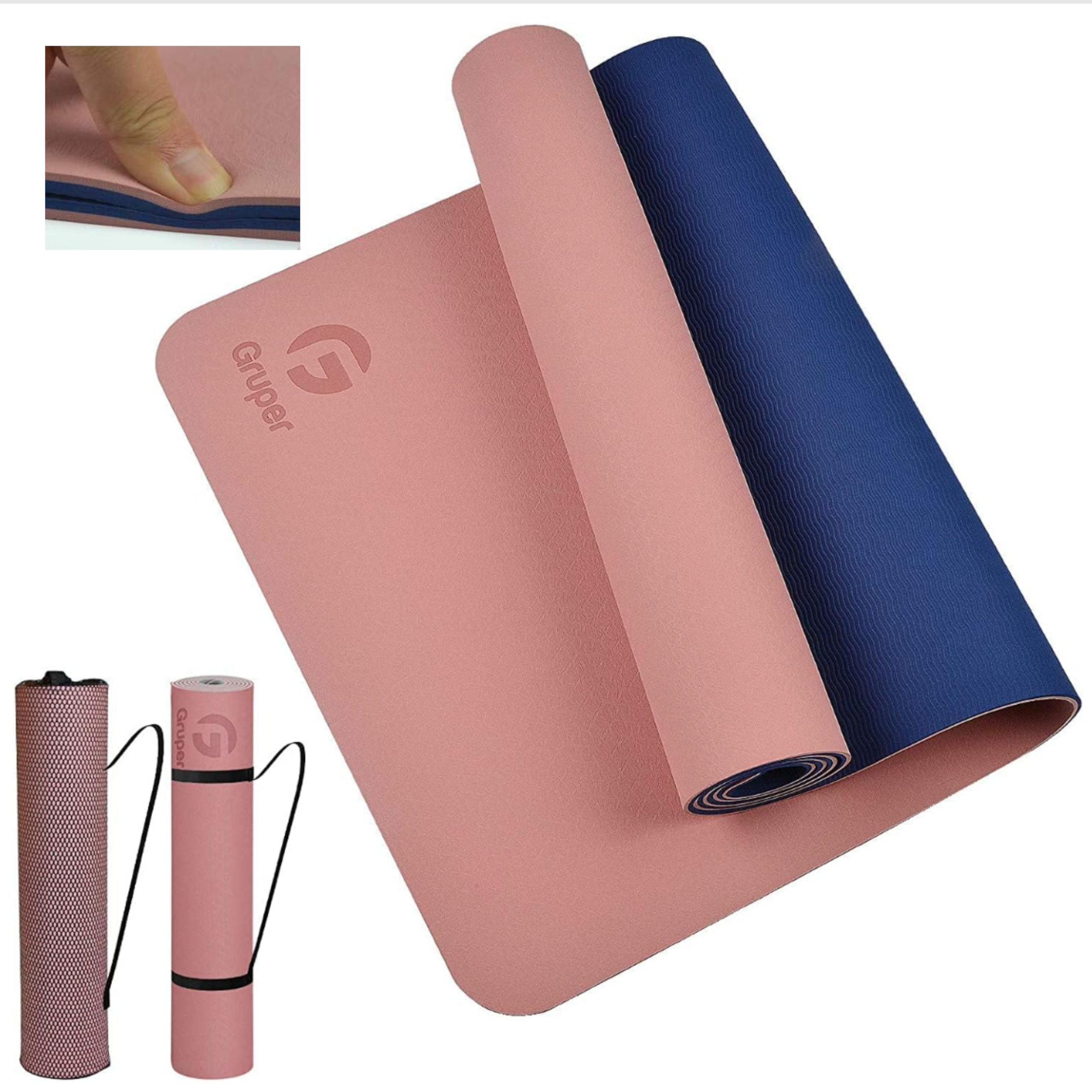
After examining this image, the viewer will be aware that the yoga mat includes a carrying bag and a strap for easy transport and folding. Additionally, they will notice that the mat features two distinct colors and a unique texture on both sides: a regular texture and a non-slip texture for enhanced grip. The image also provides a clear indication of the mat’s thickness in comparison to a thumb, showcasing its deep cushioning. Another way to obtain the best possible main image would be to consider creating multiple versions and running split tests using the Audience tool. To learn more about how to conduct a split test with our tool watch this tutorial.
The remaining product images will be a combination of infographics and lifestyle images. Infographics are images that incorporate written info, such as photos depicting product dimensions, competitor comparison charts, or simply an image of your product with text highlighting different features in a visually pleasing way.
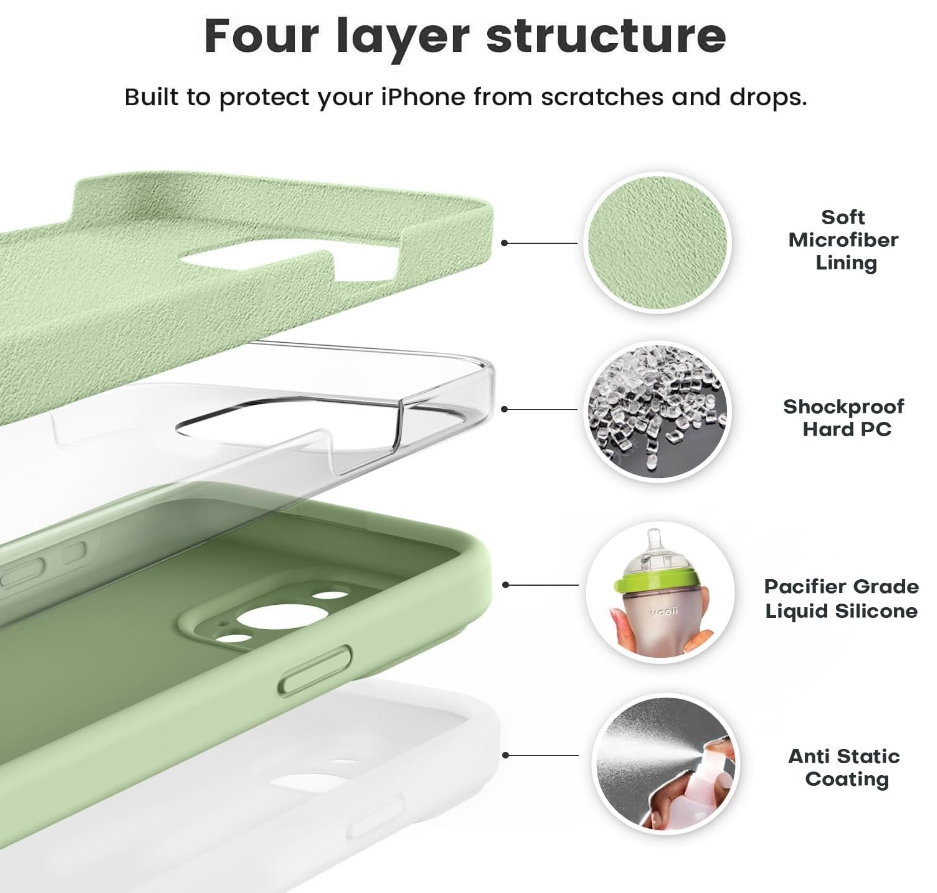
Whereas, lifestyle images are photographs that show your product in everyday use, typically with the help of a model. These are emotionally driven images – they show shoppers how they will feel when they use your product. Show it in different scenarios and settings, utilizing all of its features. You are actively selling your product images, so when you go about your Amazon listing optimization, spend a lot of time thinking about your visuals!

Optimize your Amazon listings by adding high-quality images to your Amazon listing that:
- Accurately reflect the problem that your product solves
- Clearly depict the size and scale of the product to avoid customer confusion
- Demonstrate the emotional value of using the product
- Include an infographic that highlights the unique selling proposition of your product
Search Terms
Do you have leftover keywords from your research that you don’t know what to do with or how to prioritize? What about commonly misspelled versions of popular keywords or Spanish versions of your keywords? The Search Terms field is invisible to the public but still works in your favor to index for keywords. This is your opportunity to keyword stuff without the risk of being penalized for it.
Subject Matter
Subject Matter is also part of your Amazon listing’s back end (hidden keywords) This field typically allows for a little more leeway in the way of character limit, giving you five fields of 50 characters each. Populate the Subject Matter field with your top-performing keywords to give Amazon a better idea of how to index your product, both for product categories and for organic search results. This is a method for search engine optimization on the Amazon platform to attract relevant searches.
Reviews
Product reviews ‒ they’re the lifeblood and social proof of any successful product on Amazon. While reviews aren’t typically considered part of product listing optimization on Amazon, the importance of reviews to your brand reputation cannot be understated. Using Amazon marketing tools like Follow-Up by Helium 10 is a great way to augment existing positive reviews and even to help avoid negative ones. Follow-Up allows you to set automated emails that go out to recent customers based on custom triggers, prompting them to give you honest, unbiased feedback.
Of course, you need to do your part as a seller and offer a functioning, well-made product. But you should always be reaching out to customers, asking them to write reviews. Also, when it comes to addressing negative reviews… be proactive! Respond quickly, offer generous service or refunds, or inform customers of discounts. Most Amazon shoppers use customer reviews as a way to gauge if your product lives up to the claims on your listing. Make it abundantly clear that you are a seller who cares about the quality of their product and the customer experience as a whole.
What Are Other Factors That Impact Amazon Listing Performance?
Is Amazon listing optimization one of the most powerful ways to improve listing performance? Yes. Is it the only way, certainly not. Product performance relies on a myriad of factors, including fulfillment method (FBA vs. FBM), shipping speed (Prime vs. non-Prime,) pricing strategy (competitive pricing vs. non-competitive), and the level of competition present in your product’s market niche.
Additionally, Amazon PPC plays a monumental role in product performance. While listing optimization on Amazon plays a critical role in boosting organic traffic and sales, an airtight PPC advertising strategy ensures that your product is getting visibility during vulnerable periods of time, such as a brand-new product launch. It’s important Amazon sellers understand that ranking, advertising, and listing optimization all take research and momentum, bringing them together to create an Amazon listing that shoppers cannot ignore.
Conclusion
Choosing and manufacturing the perfect Amazon product is only the beginning. To truly become an Amazon success story, you must make that product easy to find, attractive to shoppers with short attention spans, and tailor-made for the Amazon search algorithm. Amazon product listing optimization may sound like a technical process, but it really is a combination of creativity, research, and clever wordplay.
By conducting careful keyword research, then implementing high-demand keywords throughout your product listing title, description, and back-end search fields, you are loading your product listing with the fuel necessary to rocket to page one of search results and break sales records in the process!
Achieve More Results in Less Time
Accelerate the Growth of Your Business, Brand or Agency
Maximize your results and drive success faster with Helium 10’s full suite of Amazon and Walmart solutions.
